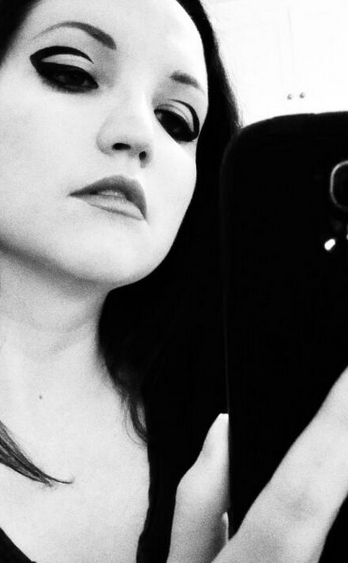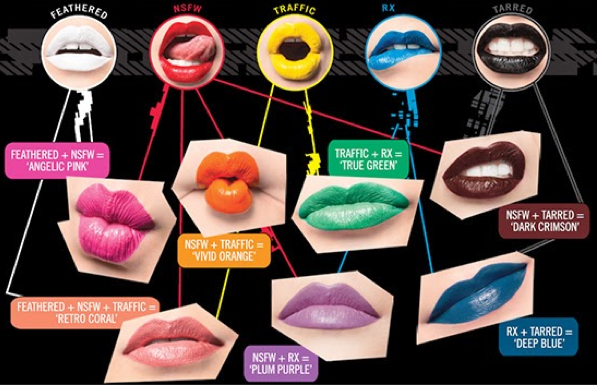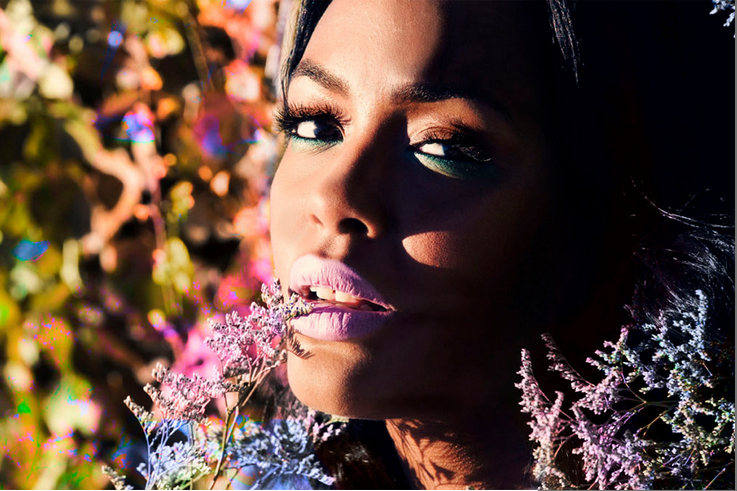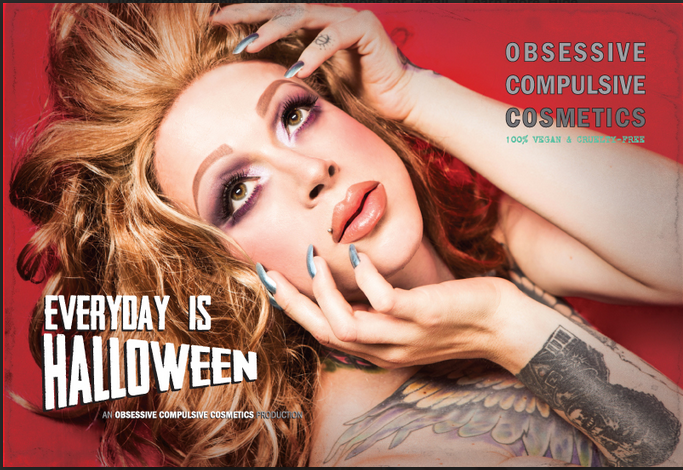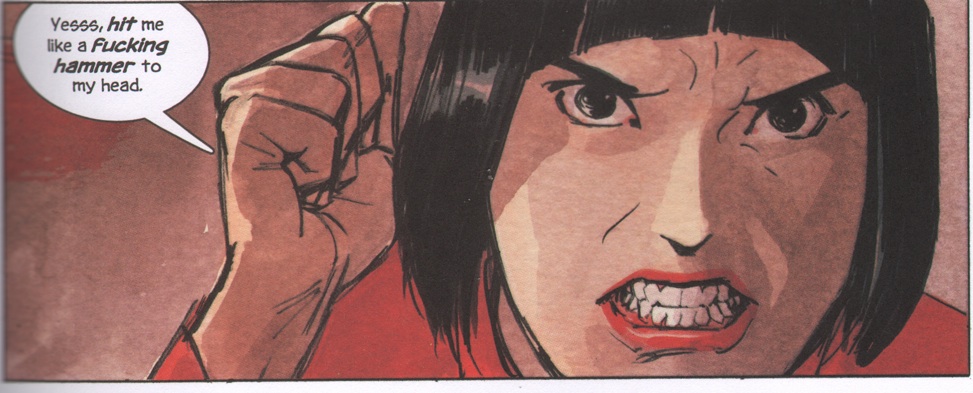
Glyn Dillon’s The Nao of Brown was released on the prestige-comic circuit last year to largely positive reviews. While most critics took issue with the work’s overly pat ending, the comic still made best-of-year lists and garnered breathless praise. Pitched as a capital-G Graphic Novel, the work aims for a sweet spot between a visceral, tear-jerking narrative and a thoughtful, complicated representation of a debilitating and misunderstood disease, with an art and writing style lousy with direct symbolism, careful repetition, and high drama. The work and its critical response function almost as a case study in the problems presented by these types of prestige narratives, especially in comic-book form, but in ways that can easily be mapped onto film, literature, and the other narrative arts. This is especially obvious when it comes to narratives about mental illness, which, with a few exceptions, are lacking or notably inadequate in mainstream and even independent media. Nonetheless, the critical response to these works, especially on the internet, tends toward a rapturous acknowledgement of the work’s affective dimension and its potential to raise awareness. The Nao of Brown is not the first or the worst offender, but it illuminates the problems with the prestige-narrative market, and the inability of those who suffer from mental illness to find just representation rather than well-intentioned but deeply misguided spectacularization. The Nao of Brown is a perfect example of this spectacularization, a work that, despite its best intentions, perpetuates deeply entrenched myths about mental illness and gender and uses its glossy surface to dissimulate a lack of faith in graphic narrative and a deep misunderstanding of what it means to have OCD.
Heartfelt Nao
Given all of this, the stakes are a lot higher than me explaining what Dillon gets wrong about OCD, and a lot higher than me hating this book. They extend to the possibilities of comics narrative, the problems of the current critical environment, and deeply entrenched myths about mental illness and gender. I think, most importantly, they extend to the responsibility that comes with writing about mental illness, given sufferers’ continued inability to find just representation in mainstream media, independent media and academic thought. I myself have struggled with primarily-obsessive OCD, and I had high hopes that this comic might correct some misconceptions about the disease, as Dillon says he intended. However, given the long history of misrepresentations of mental illness across all media, I felt frustrated, but not at all surprised, when the work didn’t measure up.
The Nao of Brown is the story of a young woman who is half-Japanese and half-British, lives in England, and works in a designer toy store for adults while being very, very cute. She also suffers from a very typical form of OCD in which she imagines committing violent acts in everyday scenarios, then is compelled to complete a series of mental rituals to banish the intrusive thought (this is known as primarily-obsessive OCD or sometimes less accurately called pure-obsessive OCD, I’ll call it PO OCD for the remainder of this article). The content of the intrusive thought and the corresponding compulsion varies widely from person to person, but Nao’s particular concerns are very common ones.
The book begins as a portrait of Nao’s day-to-day life, then chronicles her attempts to woo Gregory, a washing machine repairman who looks like her favorite anime character. He dispenses trite wisdom and generally acts like a terrible person. He’s also an alcoholic who has been sexually abused, because Glyn Dillon had a handwritten list of serious issues he wanted to work into his important story for adults. Their turbulent relationship is observed by Nao’s best friend Steve, who has, of course, been in love with her the whole time. The book reaches its climax when Nao and Gregory have a screaming match after Gregory criticizes Nao, and then he suffers a stroke. Nao is hit by a car in the immediate aftermath of the stroke, because that is also serious and important. In that moment she is able to perceive and accept the world, and we cut to a few years later. By then, Buddhist meditation has all but cured Nao of her debilitating OCD and she has become a mother (background details suggest that the child is Steve’s, but Dillon insists that it should be read as uncertain which of the two men is the father). Gregory writes a book about his experiences in which he gets to speak for himself in a way Nao is never permitted to. The End.

The Nao of Men
The whole book is interspersed with a fairy-tale sequence from Nao’s favorite anime, which would seem to add another level to the narrative but in fact comes across as entirely unrelated. The author suggests in a TCJ interview that it’s meant to be a merging of French and Japanese art as a sort of oblique way to talk about race. But the sci-fi fairy-tale itself is a conventional narrative with heavy-handed racial metaphors, and seems totally out of touch with the rest of the story, which barely touches on Nao’s Asian background.
This sequence is indicative of a problem that cuts to the core of Dillon’s writing. Nao is more of a coat rack on which to hang various “interesting” problems and big issues than a real person. Any challenges that Nao does face regarding her racial identity or her mental illness are presented in a very cursory fashion, and the overall effect is a shallow one, as if Nao were simply a compendium of character traits ranging from a quirky outlook and a preference for Amélie-inspired fashion to a biracial identity and a serious case of PO OCD. Every part of Nao’s existence seems to be of equal weight; OCD is just another thing that makes Nao “unique” and “interesting,” not a debilitating condition that can make her life unlivable. Gregory suffers from this “coat rack “problem, too, although not in such an exaggerated way. Nao is a manic pixie dream girl, straightforwardly. Gregory Pope (get it?) is also a blank slate for serious issues like alcoholism and sexual abuse, yet these are afforded the status of real, fundamental pain, with a concrete cause (the absence of a father), and thus are considered more foundational to his being and given more legitimacy by the narrative. And then we have Steve Meek (get it????), whose personality is limited strictly to his ability to name a few bands from the 80s. As a fellow namer of 80s bands, I can say that doing so doesn’t really make you interesting, nor does it obligate people to sleep with you. But Steve, along with Gregory, is the narrative’s victim, and Nao is a source of male unhappiness, presented as too absorbed in herself to take note of others. This is one of many gross misunderstandings of the nature of OCD that dovetail with a sexist portrayal of rational men and hysterical women. This isn’t Nao’s story. It’s the story of the men surrounding her and it’s by and for men.
The way the narrative places the emphasis on men is subtle, but insistent. Nao’s wisp of a roommate barely brings anything to the narrative, while the two men, especially Gregory, do the heavy lifting. Nao is the star of the novel, but only inasmuch as she has the capacity to interact with Gregory and bear Steve’s child; breaking out of her own head by being available to men sexually and emotionally. The sexism and the irresponsibility of Dillon’s narrative aren’t Dillon’s invention, nor do they seem in any way intentional. The particular brands of sexism and misunderstanding that he employs are so pervasive in media (and conversation, and criticism), that his narrative is more symptomatic than unique in any way, and the problems with his perspective and his narrative style so deep-seated that they’re easy to miss. The permissive critical environment in which comics (especially the “serious” ones) exist allows them to fester and mutate far beyond the scope of the already hurtful story Nao tells.
Professional and casual reviews of the work have repeated and refashioned misconceptions about OCD endlessly since the release of the book, allowing either reddit-style “rational” dismissal or breathless reification (“this story about OCD will make you cry ACTUAL TEARS”) to set the tone. The reviews follow the book’s lead by demanding that women take responsibility for male sexuality and male problems, admonishing mental illness sufferers to “get over it,” and establishing a sharp contrast between “real” physical pain and “false” mental pain, which just so happen to be gendered male and female in the book, respectively. The most high-profile example is certainly Rob Clough’s review at TCJ, which does a fine job of examining the strengths and weaknesses of the book overall, but makes a series of very uncomfortable generalizations about OCD, self-absorption, and mental illness. Perhaps the most egregious is his statement on Nao’s inability to perceive the problems of others:
[Nao] assumed that everyone’s behavior and attitudes had something to do with her at all times, instead of realizing that everyone else had their own set of issues. She’s incapable of seeing that Steve is in love with her and always has been, believing that he thought of her as a sister. She’s unable to see that Gregory has deep-seated pain of his own that he’s dealing with by using alcohol. While she tries various techniques to work on her issues (including “homework” that involves writing down her bad thoughts), she’s too ashamed to actually discuss them. At the same time, she’s charmingly odd in other ways.
I can’t blame Clough for making these generalizations; he’s learned them from the book itself, just as he’s learned that “real physical pain” can erase the constant, self-perpetuating suffering of mental illness without the need for therapy. The fact that so many reviewers, not just Clough, latched onto this idea is a testament to the irresponsibility of Dillon’s much-lauded decision not to overexplain OCD.
The narrative also paints Nao as a hysterical woman, unable to take responsibility for herself or others. And because she’s a woman, it is assumed that she should be taking responsibility for others and be an understanding caretaker. The work ignores the ways in which societal narratives of what women or men should do can form the very foundation of OCD, either through a scrupulous adherence to the role, a debilitating self-loathing fueled by the inability to complete the role, or more often both. At the same time, the narrative punishes Nao for thinking about herself, for putting in headphones and “blocking out the world,” for very understandably not noticing Gregory’s invisible problems or his stroke, for thinking that Steve is not in love with her. In short, for failing to perceive reality and for failing to make herself happy. She is the cause of her own unhappiness, we are told over and over.
This might be a soothing pop-Buddhist trope for most people, but imagine how painful it is for someone whose deep torment already seems divorced from his or her personality, and who already feels, from the outset, that she should be able to get over it. The knowledge of one’s own irrationality and supposed ability to overcome are simply two more pieces of OCD’s complex, self-perpetuating machinery. Dillon occasionally hints at this when he says that Nao feels guilty about her inability to meditate or to hold Steve’s hand at a kite festival, but the narrative downplays the crippling nature of this guilt for an OCD sufferer and quickly moves on to blaming Nao for her “self-absorption” again. (If only she had listened to the old woman at the Buddhist center who told her not to wear headphones while riding her bike!)
The crucial foils for Nao’s “self-absorbed” tendencies are Steve Meek, her bland but caring friend, and Gregory, who seems to be in the position of Man Who Reads Books and Should be Taken Seriously despite the almost preposterously offensive way he behaves toward Nao and her condition. Nao is punished for her failure to perceive Gregory’s problems as he forces her into the role of nagging housewife, but his failure to understand her difficulties seems to be simply “understandable” and forgivable. Both of them suffer from invisible but debilitating problems. So why does the woman come off, to my eyes, as hysterical and self-absorbed, and the man as a sage, detached survivor of ‘real’ suffering? The narrative inches up to acknowledging that Gregory is not a good person, but quickly brings us back to his perspective, seeming to suggest that his arrogance and mean-spiritedness are both wise and forgivable. Of course, people who have suffered abuse and people who have mental illness can come across as cruel and standoffish to those who don’t know what they are going through. But in my mind, the narrative justifies Gregory as the one with “real problems” and dismisses Nao.
Nao’s irrationality also means, naturally, that she’s a powder keg just waiting for someone to scream at. In real life OCD is, by and large, a quiet and isolating disease that sufferers don’t want to talk about. I don’t want to generalize the experience of OCD, but an inability to discuss the disease and a deep sense of shame are very characteristic. Furthermore, because of the lack of media representations of OCD that go beyond superficial symptoms, many PO OCD sufferers are unlikely to know what they have, or even that their condition has a name and is shared by others. Far more common, sadly, is the sense that they are losing their minds and their self-control entirely, or that the intrusive thought is indicative of psychopathic tendencies. To assume that OCD will eventually reach a point in which it is unbearable and will be revealed in a noisy, massive fit of crying and screaming is a huge narrative mistake; OCD sufferers, in general, will do anything to avoid acting as Nao does toward Gregory when they get in a fight.
In essence, the book assumes that mental illness can be placed into the simple framework of beginning, middle, end; that something has to happen to break the cycle when all too frequently, nothing happens at all. At the end of the story Nao tells us her OCD is still with her, but this isn’t demonstrated in any way. Her intrusive thoughts appear at narratively convenient moments throughout the work anyway, but the ending, in which Nao’s OCD is literally knocked out of her, and she realizes that there is no good without evil (or whatever other self-helpy platitude Gregory cares to dispense), makes the work unconscionable in a whole new way. The narrative just isn’t up to the task of explaining how and why mental illness operates; it becomes increasingly clear that Nao’s OCD is just an easy characterization or a plot motor, not a real condition, and it feels shoehorned into the conventional narrative structure of the work.
The ending of the comic brings its victim-blaming tendencies out in full relief. Nao isn’t all better, she says, but she understands that she just needs to shift her perception and be in the moment. She realizes that she is the problem. As with so many other narratives about mental illness, chemical imbalance and physiological causes are an impossibility. It’s just a matter of training yourself. For some people, this is true, and it’s also true that many methods of cognitive behavioral therapy rely on Buddhist-inspired techniques like radical acceptance. But Nao’s affirmation that “getting hit by a car was the best thing that ever happened to me,” like Gregory’s explanation of the ecstasy of a stroke, not only comes off as callous in and of itself, but leads us to the statement that really clinches the work for me: “For the first time ever, I knew something that I had absolutely no doubt about. I knew right from that cold, clear moment that that truth would never change. I am my hell, it comes from me, it’s my responsibility and it’s all my fault. But that’s fine…My problems were not problems at all, but for how I related to them.”
If this understanding helps Nao or anyone like her or me, then that’s great. But to say that the problems of mental illness “are not problems at all” is unbelievably callous. I know what Dillon means when he says this. I know he wants it to be empowering. But when the unreality of mental illness is already an incredibly common discourse used to disempower sufferers, Dillon needs to do a lot more work to justify his use of this language. The narrative hasn’t earned its ability to make that phrase empowering, nor does Dillon himself seem to understand just how paralyzing the realization that “it comes from me” can be.

Narrative and Representation
This narrative failure extends more broadly to the problems of identity that the book wants to foreground. Understanding ourselves is, I think we can all agree, an open-ended process. However, with both Nao’s OCD and Pictor the tree-man’s self-assertion in the interspersed fable, Dillon posits a self that can be untangled from its surroundings and contradictions. Pictor the tree-man, a stand-in for biracial people like Nao, ends up burning off the tree part of himself and living happily ever after. He also chops down his family tree, because he lives in a very literal world. In this particular case, context doesn’t matter at all. The self is total and is pretty much extricable from everything that surrounds it (good to know; this will save me a lot of work in grad school). Context doesn’t matter; the pure self and the pure work of art are released into the world but always stand apart from it. While avoiding the trap that suggests that mental illness is a fundamental part of identity or integral to some kind of creative vision, this interpretation veers a little too far in the other direction. Mental illness isn’t exactly a tree that you can chop down, and neither is race. Dillon fails to acknowledge this, and he also fails to acknowledge the ways in which his own art might exist in the world once it’s been separated from his good intentions.
The inadequacy of the narrative extends to many of Dillon’s artistic decisions, especially as regards pacing. Nao’s intrusive thoughts are presented in such a slow, artful, and fabulously detailed manner that it’s as if she spent time on them, imagining them in lush and decadent ways. This is a fatal misunderstanding of what it means to be obsessive. At times the intrusive thought plays out in the mind visually. At others it is imagined only conceptually or textually. But in both cases, there is no artful slow-motion unfolding. It’s an immediate thought and an immediate response, an exercise in how little time you can give to something, (which of course is triggering and causes the cycle to repeat). The slow, dramatic unfolding of Nao’s thoughts gives the wrong impression, as if they were fantasies on which she dwelled, not intrusive thoughts that she has to drive away as quickly as possible — faster than the speed of thought, and if possible even before they occur.
The representation also reads as exploitative: look at how twisted and beautiful this is, says Dillon’s art. Look at how it blurs the line between imagination and reality, look at the dramatic tension, find yourself wondering if Nao’s really snapped this time because mentally ill people have to snap eventually. The misrepresentation at work here is so pronounced that it’s easy to think that Nao indulges these thoughts as fantasies—as I’ve seen them termed repeatedly in some reviews—or even as desires. The New York Times’ blurb review buys into Dillon’s representation in an amazingly offensive way, explaining that Nao has “spent her life suppressing her obsessive-compulsive violent fantasies, and engaging with geekier sorts of fantasies,” as if these processes were in any way comparable. This might seem like splitting hairs, but it’s essential to distinguish between intrusive thought and fantasy given their dramatically different paces, temporalities, and effects on the thinker, and given the very real consequences of assuming that people with OCD are violent or want to enact their intrusive thoughts.
The representation of Nao’s intrusive thoughts as fantasies, rather than fears, extends to moments in the narrative in which she is able to think about them lucidly and critically, applying Cognitive Behavioral and Jungian therapeutic techniques despite apparently not ever having been in therapy and ostensibly experiencing her OCD at its full intensity. Her “rating system,” which ranks her level of discomfort with an intrusive thought on a scale from 1 to 10 is indeed a Cognitive Behavioral Therapy (CBT) technique. However, someone who is not regularly in therapy would have great difficulty applying it with any kind of regularity; any distance from or critical perspective on the intrusive thought is impossible from the perspective of the sufferer without serious intervention. The kind of reflection needed to rank the thought on a scale from 1 to 10 will cause the obsessive thought to recur without massive changes to the thought process of the OCD sufferer.
Dillon draws Nao’s thoughts as occurring only once, after which time she is able to reflect on them, and he seems to think that OCD occurs only during spikes rather than being omnipresent. When Nao stays home all day at the end of work, waiting for Gregory to arrive, he comes closer to approximating what OCD is really like: paralyzing. If Dillon wanted to portray Nao as in treatment or even on medication, her intermittent spikes of OCD would make more sense, as would spikes brought on by stress in other areas of her life. If he’s intending to show the disease in full, as he claims to be, then his misunderstanding is beyond belief.
An integral part of Dillon’s narrative is built around Nao drawing out her intrusive thoughts after having them (described as “homework,” the idea for this de facto art therapy is attributed to her nurse roommate). This serves a dual purpose: it lets Dillon hint at some kind of therapy without actually broaching the subject, and it lets him get away with a visual meta-narrative, suggesting that his character acknowledges the twisted beauty of her violent fantasies just like he does. The idea of an OCD sufferer, especially one not under any kind of treatment, being able to draw out their intrusive thoughts in any way is simply unthinkable, and it highlights the depth of Dillon’s misunderstanding of how PO OCD manifests itself. Intrusive thoughts don’t go away after a single, intense episode. Any reminder, no matter how small, of a past thought will cause the sufferer to repeat the cycle. Consequently, any act that makes the thought more real, including writing, drawing, or even speaking about it, is avoided by the sufferer in almost all cases.
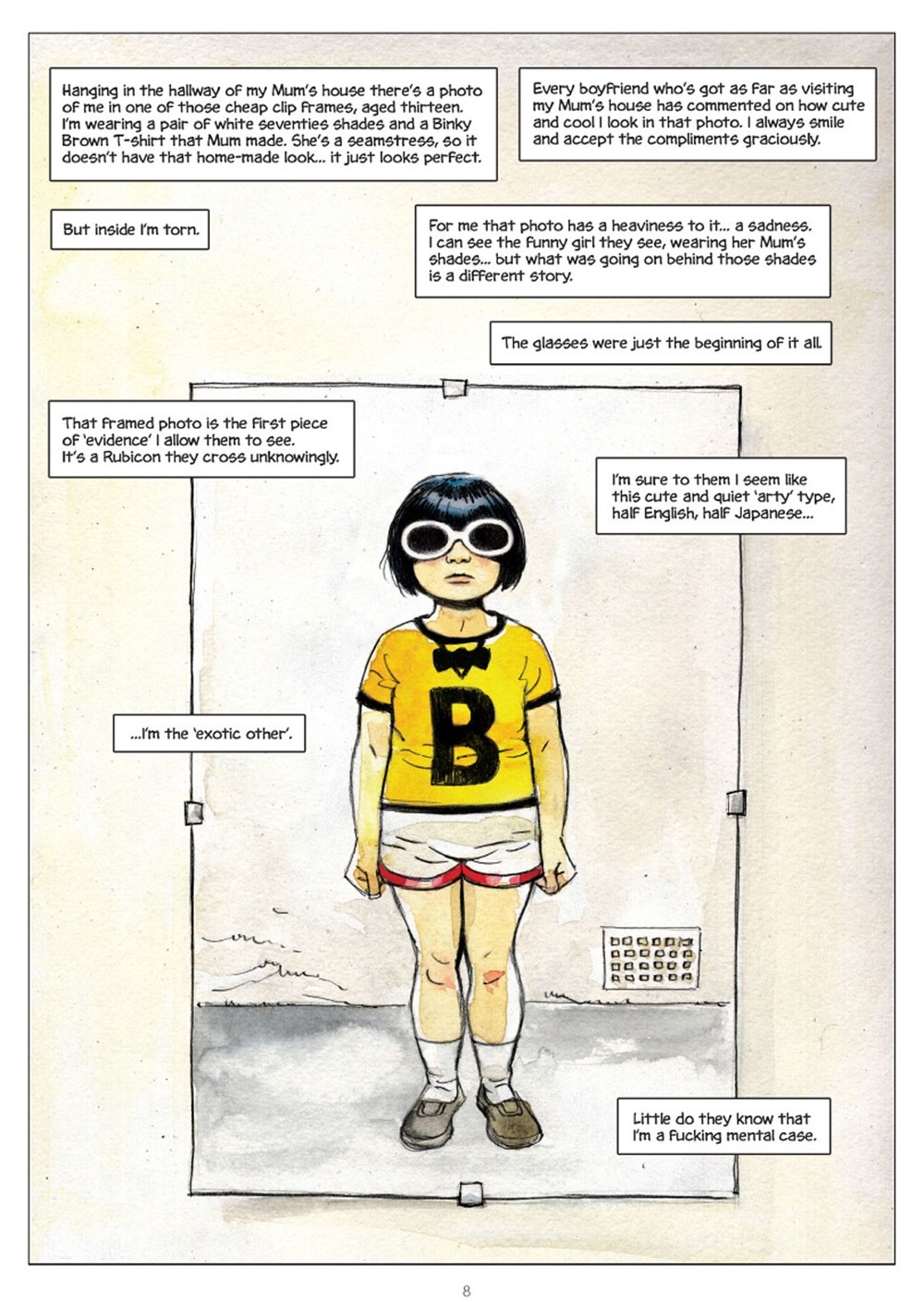
Binky Brown and the Nao of Brown
Despite the implausibility of an OCD sufferer drawing out her intrusive thoughts, Dillon’s attraction to visually depicting OCD makes sense. Comics are uniquely positioned to talk about PO OCD, I think, given their ability to move very freely between the mental and physical worlds and the fact that the intrusive thoughts and the accompanying rituals often take on hybrid visual, conceptual, and verbal components. Comics also have the distinction of being the medium of choice for the only two thorough pop-culture representations of PO OCD of which I am aware: The Nao of Brown and Binky Brown Meets the Holy Virgin Mary (if you know of any others, please let me know; my research on this only led to depictions of other forms of OCD).
Binky Brown does a fairly good job of depicting PO OCD, and the struggles of its sufferers to identify their disease, in that it’s an agonizing book to read (and one that, I confess, I could not read in full). However, it’s also very limited by its cultural moment. It’s one of the founding documents of underground comix, so it’s natural that it should feel so underground, and to say that it’s limited by its moment doesn’t mean that I think it’s derivative, or that it’s lacking. Rather, I think it’s circumscribed by the kinky sensibility of underground comix, which always places the reader at a voyeuristic distance from Binky Brown (he acknowledges as much on the first page, even as he also calls out to others who share his condition to empathize). In many ways, this is preferable to the all-access pass that The Nao of Brown purports to offer the reader; it acknowledges the specificity of Binky’s condition and the difficulty of understanding. But in the wrong hands, it can come off as exploitative and stigmatizing. It’s also limited by a deeply psychoanalytic sensibility that attempts to trace Binky’s OCD to certain moments of his life, especially early encounters with the idea of sex. These follow very conventional narratives on insanity and neurosis, and it is common to recur to these kinds of narratives as a coping device. The sufferer often feels better about her condition if she can say “It all started when…” This means that Binky’s illness, like Nao’s, is presented through a beginning, middle, and end structure in which he finally overcomes the disease. In this case I’m more forgiving, rightly or not, because it is Justin Green’s perspective on a personal experience, and the process of constructing a narrative may be very healing for him. I prefer Binky Brown’s openly visible limitations to Nao’s feel-good universality, even if Green’s limitations are fairly serious in terms of the story they tell about OCD.
Nao attempts, and fails, to pick up on the tradition of comics about PO OCD by referencing Binky Brown on its first page. But it also backs down on the possibilities of comics storytelling by including an excerpt from Gregory’s infuriatingly-titled memoir, How Now Brown Cow. To me, this comes across as a lack of faith in comics. When really important things need to be said (by men), text steps in to pick up the slack, and the visual is relegated to a plain brown background and a little bit of shading on the pages of the book. In the end, the one who gets to speak for himself is Gregory, the “real” victim, in a rational, text-based way that gives little to no credence to Nao’s (heavily visual) experience. The text has already done some awkward heavy lifting—the book was written in the style of a screenplay—but here visual narrative is discarded for a full two pages.
This could be striking and interesting if it felt more like an artistic choice and not a compensatory move, a real lack of faith in what can and should be told by graphic narrative. It links Nao and the feminine to the visual and the unspeakable. On the next page, she has a vision of herself as a flower and is warned against becoming self-important as a result of the experience. Meanwhile, Gregory is somehow allowed to assert, via text, that he has been able to free himself from attachment, and also make such (profound!) statements as “the ego is the price we pay for poetry.” The extent of his engagement with Nao’s disease is his acknowledgement that she was being “very agitated and unpleasant,” and that this probably stemmed from some kind of unhappiness. The final word on Nao’s life also comes heavily filtered through Gregory via a long quote about Abraxas, apparently lifted from Jung. Nao and her son might get the last image, but Gregory gets the last word, and given the way the text has worked with word and image, Gregory’s verbal contribution is infinitely more serious and important than anything Nao herself can bring to the table.
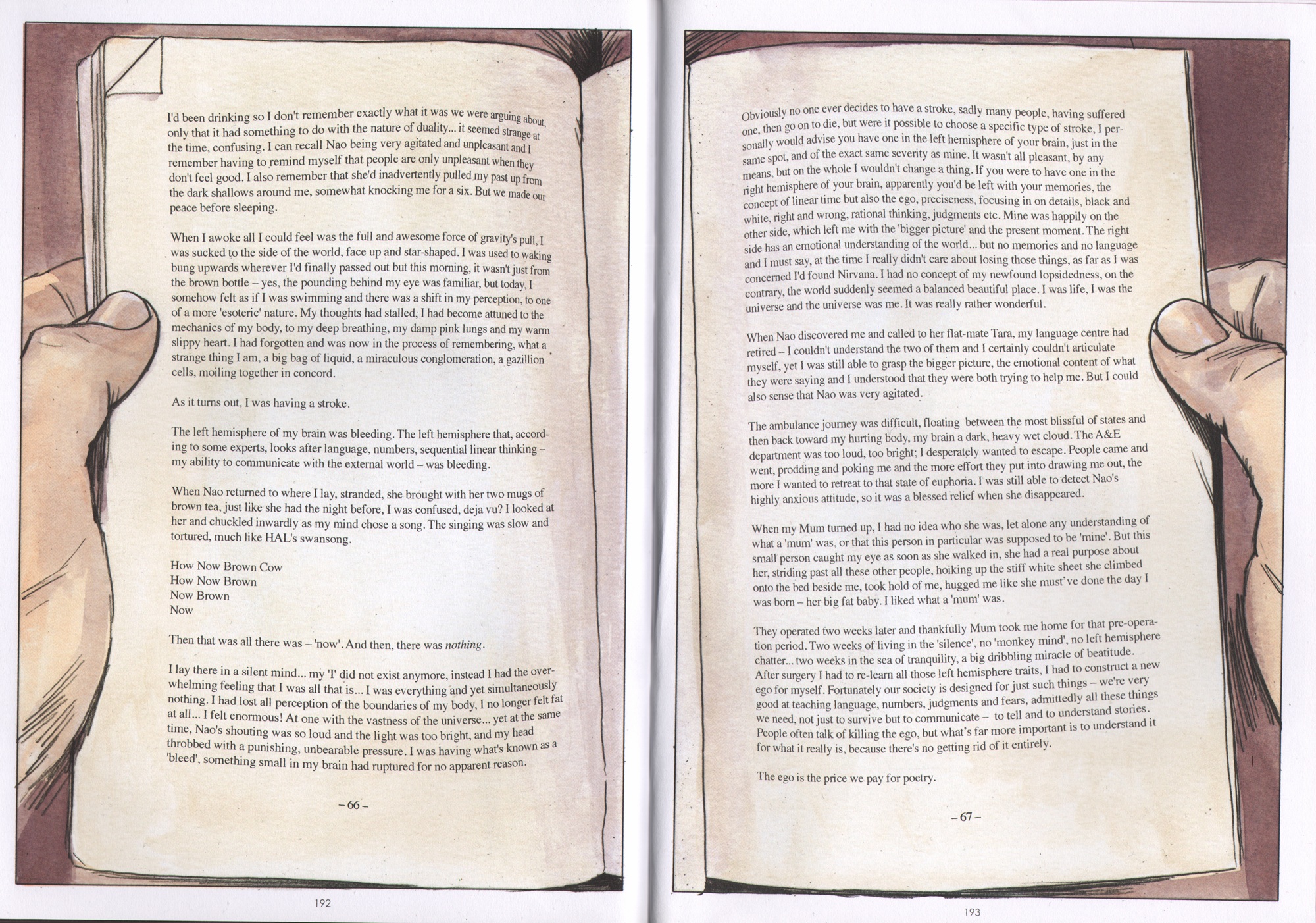
Explanation and Feeling
I’m not asking for a perfect narrative, and there’s no ethical line in the sand that can be reasonably drawn when it comes to representing mental illness. But I do think it’s reasonable to ask for more than Nao gives us in terms of responsibility to both its audience and to sufferers of the disease it depicts. This is especially important because Nao, as the protagonist of one of only a few narratives about PO OCD, is inevitably going to stand in for PO OCD sufferers.
Dillon’s much-lauded decision to not “overexplain” Nao’s disorder would make sense in a world where PO OCD is widely known and understood. But in our world, where OCD is still synonymous with “neurotic,” “eccentric,” or “organized,” where it is often depicted as the key to personality and intelligence, and where it is frequently assumed that “we’re all a little bit OCD,” it’s irresponsible for Dillon to allow himself that luxury. To do so further propagates hurt, misunderstanding, and stigma, and it’s a shame because it’s a waste of both a good opportunity and excellent intentions. Dillon set out to write this work specifically due to a gap in media about PO OCD, and it is my sincere hope that people who read it and have been struggling with similar issues will find by reading the work that their condition has a name and is shared by many people.
That said, I hope that they won’t take the pop-psychology, the lack of any mention of professional help, and the victim-blaming at the core of The Nao of Brown to heart. Dillon doesn’t seem to have done his research on OCD or on the methods of treatment; he decides not to “overexplain,” but it’s hard not to feel that if pressed, he would be unable to explain the mechanisms of PO OCD and the pattern of intrusive thought and compulsion that characterizes it. In the aforementioned TCJ interview, Dillon explains that the narrative was initially about Gregory, because he was interested in the idea that washing machines might have some otherworldly connection. Once he decided that Nao, originally a minor love interest, would have OCD, he became more interested in telling her story as a reflection on quiet and unquiet minds.
This explains quite a lot. While he notes in an interview with OCD UK (unfortunately not available online) that he discussed the disease with his wife, who has struggled with it, and that he read several books and some online forums about OCD, he simply doesn’t understand what it’s like to have OCD. He also seems to have trouble differentiating the average person’s struggle with meditation and stress from the experience an OCD person might have. A host of other misunderstandings grow out of this initial one; reviewers like Seth Hahne of Good OK Bad pick up on the societal narrative that we’re all a little bit OCD, saying things like “it’s easy to see why few people realize that [Nao is] troubled any more than the next person on this sad, strange globe. In fact, she comes off at a glance better than a great number of us regular citizens,” or, “I think the questions that fuel Nao’s dreams and fears are the questions that haunt and help whole populations of this earth.” Dillon says that he wrote this work specifically for people with OCD and not for others. This is a well-meaning attitude that also happens to be dangerously arrogant; of course the book won’t only be read by OCD sufferers and of course it will be misinterpreted if you refuse to offer any tools for interpretation or understanding.
This feeds into a larger problem with the ways in which these kinds of SERIOUS narratives are received: in terms of affect, or in terms of increased awareness, both of which tend to foreclose real engagement and understanding. Both popular and professional criticism, especially in comics, tend to accord prestige to these types of narratives simply for going through the affective motions. “Low” internet culture calls this “feels,” and those with pretensions to “high” internet culture, like Seth Hahne, call it “a delicate admixture of sobriety and humour,” but the end result is the same, and both are entirely inadequate to address the narrative and the nature of real-life mental illness.
Affect is an important part of reading, and the ways in which we respond to works are valid. However, that doesn’t mean that criticism should just involve telling everyone how much something made you feel. Feeling is a complement to, not a substitute for, critical thought. Even the reviews I read that had literary pretensions, comparing Nao to the great(ish) works of contemporary lit, fell back on this affective dimension to explain why the narrative was IMPORTANT and INTERESTING (and not too depressing!), rather than on any kind of critical analysis. When we as critics participate in this kind of conversation, or when we share that Upworthy post (You Won’t Believe What This Woman Has To Say About Depression)! we’re positioning ourselves as people who observe mental illness for our amusement/catharsis.
It’s a tricky situation, because there is a sense in which just raising awareness can be helpful; Nao and that one episode of Girls, whatever their other merits, do seem to have gotten people talking about OCD. However, awareness is only a tentative preliminary step on the path to real engagement with other people. The rise of the awareness-industrial complex has foreclosed the possibility of understanding even further. Awareness is important, but it’s hardly sufficient. When you’re talking about an illness like OCD, which just about everyone is aware of but few people understand, the problems of awareness come into sharp relief.
This is a second problem for all readers: and it’s a tough one. Where do we draw the line in telling authors and corporations that the minimal acknowledgement of our existence isn’t enough, and that it’s not necessarily good? While the arrival of the first [insert identity category] character in any mainstream media often sets of a wave of interesting discussions about identity and representation, the post that goes viral is almost always a wildly enthusiastic response, no matter how stereotyped, tokenistic, or coy the representation in question. While there is value in seeing someone who looks like you or thinks like you or desires like you on the big screen or in a major book, I no longer want to give anyone the message that any representation, no matter how mistaken, is acceptable. I will no longer tell anyone, from small-time authors to major corporations, that they can not only get away with tokenism, but that they will be greatly rewarded for it. I no longer want to give anyone points for recognizing that various groups of people exist, and if that recognition involves speaking for me, I’m even less interested.
Some people with OCD have responded enthusiastically to The Nao of Brown, and I am not, in any way, here to take that away from them. I am glad that the experience was a positive one for them. However, we as critics and readers need to stop assuming that the bare fact of representation and minimal awareness is always a positive one. Just as affect isn’t sufficient for a critical and understanding engagement with another person, awareness isn’t enough. And we need to think long and hard about where these messages of awareness are coming from, and to whom they are addressed. I’m glad to see PO OCD getting more attention. But I would like to see it getting the kind of attention Fletcher Wortmann, Mara Wilson or Olivia Loving have been giving it, or in the world of graphic narrative, the kind of attention that Epileptic gave to mental and physical illness. (Seth Hahne compares Nao favorably to Epileptic because it’s not so “mopey,” wrapping it up with an always-timely lighthearted reference to suicide. To his credit, he also invites ”heated discussion” about the work, so, here I am!) To really talk about mental illness, we need to invent new ways to talk about it that don’t follow the same old narratives, if Nao can send us down that path, all the better. But we’re not there yet.
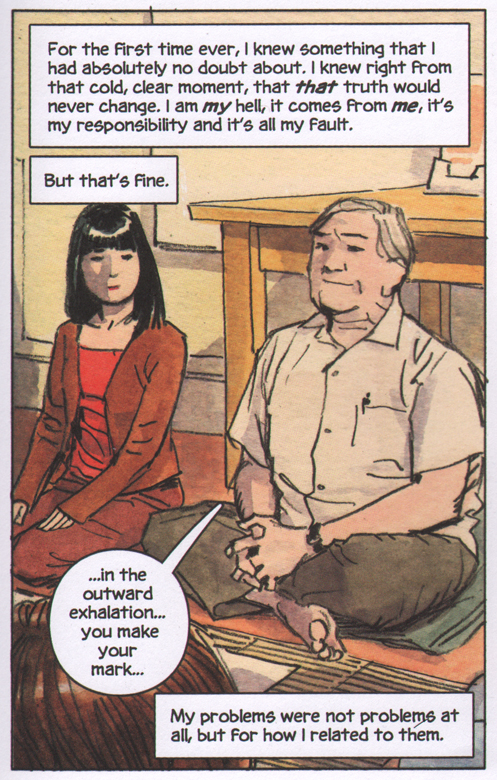
Nao’s intentions are positive, and I want to give Glyn Dillon credit for addressing the issue of PO OCD. It has the potential to do some good, and for many OCD sufferers, it already has. By the same token, I do not think that his intents were sexist or otherwise discriminatory. I am aware that he is telling the story of one person’s OCD, and not mine or anyone else’s. But that doesn’t address the fundamental problem: the narrative is feeding off of a larger context of sexism and the stigmatization of mental illness, and it’s reinforcing them because it steadfastly refuses to explain the condition or challenge many deep-seated notions about mental health. Out of context, perhaps in a parallel universe, Nao isn’t so bad. But in a world where seeking out mental health care is likely to get you told that you’re either crazy or one of the conformist sheeple masses, Nao becomes untenable really quickly. I know what Dillon means when he says that Nao’s problems “are not real problems.” I know that his intentions are good. But when he says those words, they’re riding on the wave of thousands of stigmatizing, generalizing, hurtful statements that have been made about mental illness’ unreality. And when he makes a work like Nao, he is feeding into a long tradition of prestigious narratives about serious issues the make a visual and emotional spectacle of their subjects and promote awareness, but never engagement.
Thanks to Jacob Canfield and Noah Berlatsky for helping me complete this article and for being very patient with the long process of writing it.
___
Update: Quotes around one phrase were removed so it was clear they were not meant to be attributed to Seth Hahne (see comments below for fuller discussion.)



